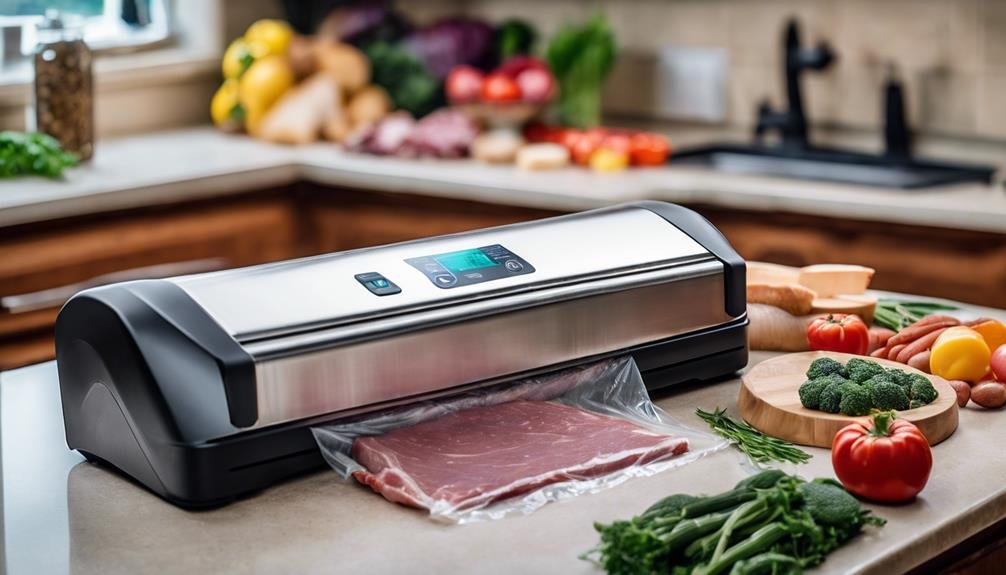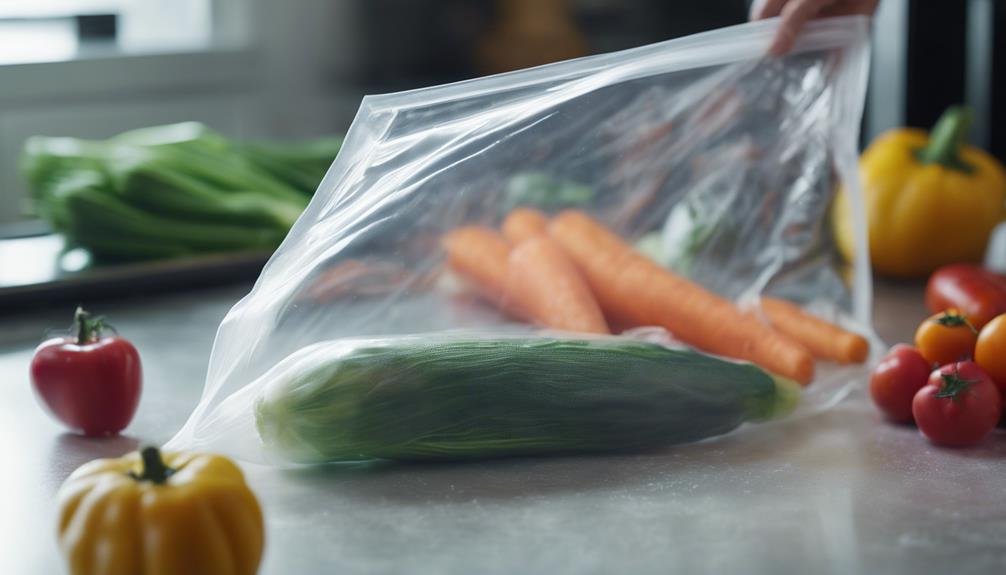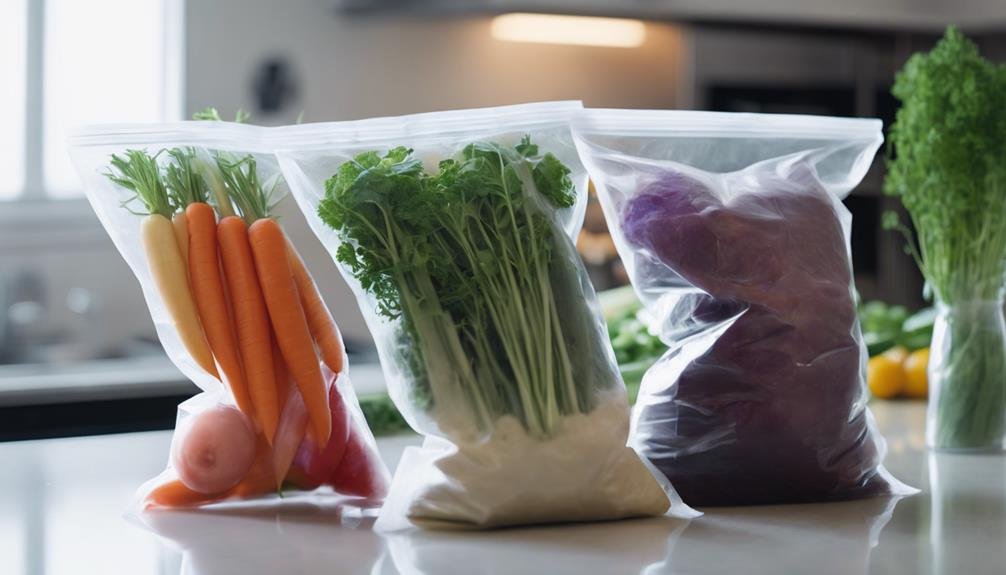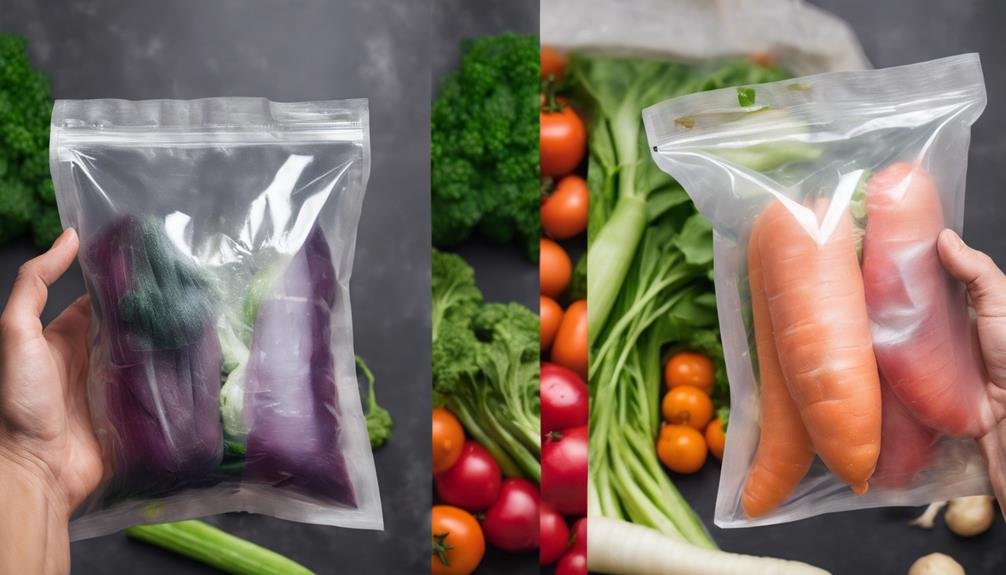Vacuum sealing preserves food flavors by removing oxygen from around your ingredients. This process creates an anaerobic environment that prevents oxidation, which can lead to flavor loss and spoilage. By sealing out air, you're safeguarding natural flavors and volatile compounds responsible for taste and aroma. The result? Your food stays fresher and tastes more intense for longer periods. Vacuum sealing also protects against freezer burn, moisture loss, and contamination from other odors. To get the best results, properly prepare your food, use high-quality bags, and guarantee a tight seal. With the right techniques, you'll open up a world of flavor preservation possibilities.
The Science Behind Vacuum Sealing
At the core of vacuum sealing's flavor-preserving power lies its ability to remove oxygen from around your food. When you vacuum seal your ingredients, you're creating an environment that's inhospitable to the processes that degrade food quality over time. By removing oxygen, you're preventing oxidation, which can lead to flavor loss and spoilage.
Vacuum sealing doesn't just remove air; it creates a protective barrier that locks in the natural flavors of your food. This process preserves the volatile compounds responsible for taste and aroma, ensuring that your ingredients retain their original flavors for longer periods. You'll find that vacuum-sealed foods often taste fresher and more intense than those stored using conventional methods.
The science behind vacuum sealing is straightforward but highly effective. When you remove oxygen, you're essentially putting a stop to the natural aging process of your food. This means that the delicate balance of flavors in your ingredients remains intact, allowing you to enjoy them as if they were freshly prepared.
Whether you're storing herbs, meats, or even baked goods, vacuum sealing helps you preserve food flavors with remarkable efficiency.
Benefits for Food Preservation
Now that we've explored the science, let's examine the practical benefits of vacuum sealing for food preservation. This innovative food preservation technique offers numerous advantages for maintaining the quality and flavor of your favorite foods.
Vacuum sealers create an anaerobic environment, effectively eliminating oxygen exposure. This process preserves the original taste and aroma of your food, preventing oxidation and flavor deterioration. You'll enjoy the authentic flavors of meats, fruits, and vegetables for much longer periods.
The benefits of vacuum sealing extend beyond flavor preservation:
- Longer shelf life: By removing air and sealing food tightly, you'll greatly extend its storage duration.
- Moisture retention: Vacuum sealing prevents moisture loss, keeping your food fresh and free from freezer burn.
- Odor protection: Your sealed foods won't absorb unwanted odors from the surrounding environment.
- Contamination prevention: The airtight seal protects against bacteria and other contaminants.
Selecting the Right Vacuum Sealer

Selecting the appropriate vacuum sealer is essential for maintaining the distinct flavors of your favorite foods. When choosing a vacuum sealer, consider the types of food you'll be preserving. Look for models with adjustable settings that allow you to customize the sealing process for different foods. This feature is particularly important for delicate items like herbs and fruits, which require gentler handling.
Opt for a vacuum sealer with a pulse mode, which gives you greater control over the sealing process. This feature is ideal for preserving delicate foods without crushing them. Additionally, consider a model with a gentle vacuum pressure setting to protect sensitive foods' flavors.
If you enjoy marinating food before sealing, choose a vacuum sealer with built-in marinating options. This feature can enhance flavors and save you time in the kitchen.
Here's a comparison of vacuum sealer features to help you make an informed decision:
| Feature | Basic Model | Mid-Range Model | Premium Model |
|---|---|---|---|
| Adjustable Settings | Limited | Moderate | Extensive |
| Pulse Mode | No | Yes | Yes |
| Gentle Vacuum Pressure | No | Yes | Yes |
| Marinating Option | No | No | Yes |
| Sealing Customization | Basic | Advanced | Professional |
Preparing Foods for Sealing
To maximize flavor preservation when vacuum sealing, you'll need to properly prepare your foods before the sealing process begins. Start by ensuring your ingredients are clean, dry, and free from excess moisture. This step is essential for maintaining the integrity of flavors during storage.
When it comes to meats and vegetables, consider seasoning them before sealing to enhance flavor retention. Marinating is another effective technique to infuse flavors and tenderize meats before vacuum sealing. By allowing the foods to absorb the marinade, you're locking in those delicious tastes for later enjoyment.
Remember to use high-quality, airtight bags to prevent flavor transfer and maintain food freshness.
Here are four key points to keep in mind when preparing foods for vacuum sealing:
- Clean and dry ingredients thoroughly
- Season or marinate foods before sealing
- Use appropriate vacuum sealing bags
- Avoid mixing strong-smelling foods in the same bag
Best Practices for Optimal Results

Once you've properly prepared your foods, it's time to focus on the best practices for vacuum sealing to guarantee the best flavor preservation. To achieve ideal results, you'll want to make sure you're creating an effective anaerobic environment. This means removing as much oxygen as possible from the packaging, which is essential for preserving food flavors and retaining freshness.
When vacuum sealing, make sure your bags are properly sealed without any wrinkles or air pockets. These can compromise the seal and allow oxygen to seep in, potentially degrading flavors over time. It's also important to use high-quality vacuum sealer bags that are suitable for the type of food you're preserving.
Don't overfill your bags; leave enough space for the air to be removed effectively. If you're sealing liquids or moist foods, consider pre-freezing them to prevent moisture from interfering with the seal. Remember, the goal is to lock in natural juices and flavors while keeping oxygen out.
Regularly check your vacuum sealer's performance and clean it as needed to ensure it's working efficiently.
Storing Different Food Types
Different food types require specific vacuum sealing techniques to maximize flavor preservation and shelf life. When vacuum sealing meat, you'll prevent freezer burn and oxidation, keeping your beef, poultry, and fish tasting fresh for longer.
For fruits and vegetables, vacuum sealing helps maintain their flavors and extends their shelf life greatly.
Coffee enthusiasts will appreciate how vacuum sealing preserves the aroma and taste of both beans and ground coffee. You'll also find that cheese retains its original flavor and texture when properly sealed.
Don't forget about nuts and crackers – vacuum sealing keeps them fresh and flavorful, reducing the risk of rancidity.
To get the most out of vacuum sealing food, follow these tips:
- Pre-freeze soft or moist foods before sealing to prevent crushing
- Use appropriate bags or containers designed for vacuum sealing
- Remove as much air as possible for excellent preservation
- Label and date your sealed items for easy tracking
Extending Shelf Life of Ingredients

While proper storage techniques are important, vacuum sealing takes ingredient preservation to the next level by greatly extending the shelf life of your food items. By creating an oxygen-free environment, vacuum sealing markedly slows down food degradation, allowing you to keep ingredients fresh for much longer periods.
When you vacuum seal your ingredients, you're not just preserving their physical state; you're also safeguarding their natural flavors and aromas. The absence of air in the sealed bags or containers prevents oxidation of oils and fats, which is essential for maintaining the taste and quality of your food. This means that when you finally use those vacuum-sealed ingredients, they'll taste just as fresh as the day you sealed them.
Moreover, vacuum sealing helps your ingredients retain their original textures and nutritional value. By eliminating air exposure, you're effectively halting many of the processes that lead to flavor loss and quality deterioration.
Whether you're storing meats, vegetables, or even dry goods, vacuum sealing offers an excellent way to extend shelf life while preserving flavors. It's an investment in both the longevity and quality of your ingredients.
Flavor Enhancement Techniques
Beyond preserving existing flavors, vacuum sealing can actually enhance the taste of your food through various techniques. By removing air and creating an airtight seal, vacuum sealing is essential in safeguarding against oxidation and moisture loss, guaranteeing that your ingredients maintain their original flavors and aromas. This process of flavor retention is vital in preserving the integrity of your dishes, allowing you to enjoy them as if they were freshly prepared.
To maximize the flavor-enhancing potential of vacuum sealing, consider these techniques:
- Marinate before sealing: Vacuum sealing intensifies the absorption of marinades, resulting in more flavorful meats and vegetables.
- Infuse herbs and spices: Seal aromatic ingredients with your food to impart subtle flavors during storage.
- Portion and season: Pre-season individual portions before vacuum sealing to save time and ensure consistent flavoring.
- Sous vide cooking: Use vacuum sealed bags for sous vide cooking to lock in flavors and nutrients.
Common Mistakes to Avoid

Now that you've learned how to enhance flavors with vacuum sealing, it's important to understand the common mistakes that can undermine your efforts and compromise food quality.
When using vacuum sealers, avoid overfilling bags, as this can prevent proper sealing and preservation of food flavors. Don't seal items with sharp edges directly in vacuum bags, as they can puncture the plastic and cause a loss of vacuum seal.
Before vacuum packing, make sure you've properly cleaned and dried your food items. This step is vital for maintaining original flavors and preventing contamination.
When sealing and freezing, pay attention to the sealing area of the bag. Wrinkles or folds can lead to air leakage, compromising the seal and potentially affecting food flavors.
After you've finished vacuum packing, store your sealed items in a cool, dry place away from direct sunlight. This practice helps maintain freshness and preserves flavors, especially for foods stored in the freezer.
Conclusion
You've now unsealed the secrets of vacuum sealing, preserving flavors like a culinary time capsule.
Armed with this knowledge, you're ready to initiate your own food preservation odyssey. Remember, like a skilled alchemist, you'll transform ordinary ingredients into long-lasting treasures.
Don't let common pitfalls be your Achilles' heel. Instead, embrace these techniques, and you'll soon be sealing in flavors that rival Olympian ambrosia.
Your kitchen's about to become a fortress against time's ravages.
